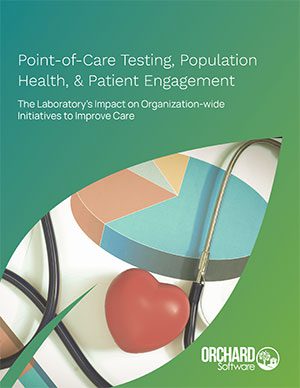 Population health management (PHM) requires both human interventions and effective, interoperable health information technology (HIT) tools. HIT tools are imperative to house the data and perform the analytic tasks necessary for efficient PHM. HIT tools are also necessary to identify and stratify patient groups, generate alerts or messages that communicate with providers and patients, and perform follow-up metrics to analyze progress (see Figure 1). Interoperability among HIT tools is vital to promote data sharing across healthcare organizations (HCOs), allowing for analytics on a broader scale.
Population health management (PHM) requires both human interventions and effective, interoperable health information technology (HIT) tools. HIT tools are imperative to house the data and perform the analytic tasks necessary for efficient PHM. HIT tools are also necessary to identify and stratify patient groups, generate alerts or messages that communicate with providers and patients, and perform follow-up metrics to analyze progress (see Figure 1). Interoperability among HIT tools is vital to promote data sharing across healthcare organizations (HCOs), allowing for analytics on a broader scale.
More than the EMR
While an EMR/EHR is an integral part of a PHM endeavor, other HIT tools and data are needed for a comprehensive PHM effort. Healthcare facilities often use the tools that are available as part of other information systems even though these can be rudimentary and not designed specifically for PHM. As lab data is a critical element in PHM, these efforts are more likely to succeed with effective, interoperable systems that include an integrated LIS and EHR
Clinical & Claims Data
Often, PHM efforts begin with a combination of claims, lab, and EHR data. Being able to integrate clinical and claims data provides insights into what is going on with the patient, which help physicians take specific actions, such as encouraging patients to take their medications or comply with follow-up visits.
Disease Registries
Electronic registries, fed by EHR and administrative data, are a rich source of actionable data and risk stratification reports. There are also benchmark registries that allow HCOs to measure care plan effectiveness for certain conditions, such as heart disease and diabetes, compared to national averages. When such registries are coupled with evidence-based clinical protocols based on national standards, specially designed applications can generate messaging to patients to make appointments for necessary chronic and preventive care.
Data Warehouse & HIE
Large HCOs and Integrated Delivery Networks (IDNs) use data warehouses to aggregate data from multiple sources, including clinical and claims data and patient registries. Health information exchanges (HIEs) that cross HCOs and geographical areas can be beneficial to a large PHM program as data from multiple entities is amassed and made available from the HIE. With comprehensive data available, providers can access patient information in real time to improve clinical decision-making at the point of care.
Patient Portal & PHR
Patient portals and patient health records (PHRs) are available IT tools that allow patients greater access to their health data. PHRs that are linked to EHRs combine data and educational tools to help patients be more active in their healthcare plan. Ideally, the PHR should include as much relevant data as possible over a person’s lifetime from multiple sources. Yet, PHRs are still evolving and not widely in use. Widespread use of PHRs will only happen when they become more convenient and affordable and patients see their benefit.
Download Our White Paper for on Population Health for More Details
 To learn more to learn about how laboratory professional oversight of POCT can enhance POCT’s ability to positively impact patient engagement and outcomes, download Orchard’s white paper today.
To learn more to learn about how laboratory professional oversight of POCT can enhance POCT’s ability to positively impact patient engagement and outcomes, download Orchard’s white paper today.
Our Commitment
Orchard is committed to keeping you informed and being a trusted resource you can turn to for industry-related education. As always, we welcome your feedback. Follow us on Twitter at @OrchardSoftware, and feel free to respond to this post by emailing us at news@orchardsoft.com.
